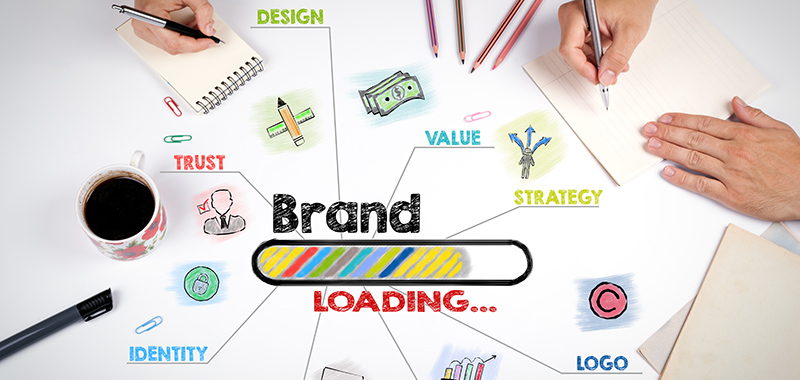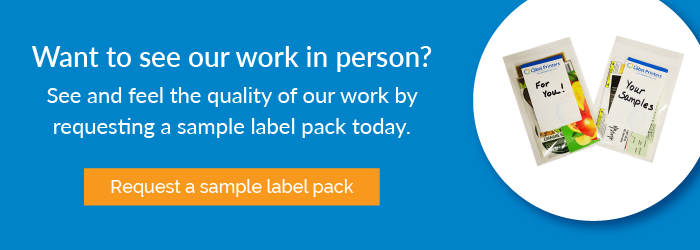
Marketing experts will tell you that a brand isn’t something you own. A brand is the sum total of people’s perceptions of a product or company, meaning that your company’s brand lives in the minds and hearts of your customers and potential customers. But with every word, image, and product you put out into the world, you can communicate ideas about your company’s values and the people you wish to attract. You can build a brand.
And your product label? It’s central to the story of your brand.
How Labels Shape Brands
Product labels may be the first way customers experience your brand and the most frequent reminders of your brand.
Consider the label on a bottle of craft beer.
A beer enthusiast scanning the shelves for a new brew won’t have much to go on other than the label. To catch the new buyer’s eye, a label has to convey basic information, such as the type of beer (IPA, stout, hefeweizen). But the label also has to (in a few fleeting seconds) promote an identity and experience that strikes a chord with the buyer.
Of course, the product itself has to live up to that brand promise. But a label’s job isn’t done once a product is selected off the shelf. Suppose our beer buyer shares a bottle with a friend, who also enjoys the beverage. The brand elements of the label must be strong enough for the friend to remember the beer and find it again in stores.
It’s not just beer. Labels are key branding elements for almost any retail product, including fine wines, cosmetics, and toys.
Here are a few tips to help your brand sing out loud and clear through your label:
Align Your Label With Your Other Brand Elements
Like a new set of clothes, your product can be an opportunity to redefine your image radically — but be aware of any jarring inconsistencies between your label and your other brand materials and assets, like your website.
If, for example, your website and ads use bold colors and in-your-face imagery to portray a fresh, irreverent vibe, your label should do the same. Understated colors and reserved messaging on your labels may confuse or even repel buyers who expected something very different from you. Work with your label designer and label printer to identify the brand elements you want to carry onto your labels.
Choose Your Colors With Care
Some brand colors are so iconic, you hardly need anything else to identify a company: UPS brown, Coca-Cola red, John Deere green. Choose the right color or combination of colors, and your label could become a legend.
But color does more than linger in our memories; color can be persuasive. According to at least one study, 62 to 90 percent of our initial assessment of products might be on color alone.
What do your brand colors say? Different colors are traditionally and psychologically associated with different emotions and values:
- Red can signify love, passion, and excitement (as well as anger).
- Purple signals creativity, wealth, and luxury.
- Green instills a sense of relaxation and is connected to health and nature.
- Yellow shouts “sunshine,” “fun,” and “laughter.”
Fortunately, depending on your budget, modern label printing technology allows for a broader (and more precise) color palette than ever before. Your label printer can help you make sure the colors on your label turn out exactly the way you envision them.
Get Into Shape
Shapes, like colors, also make powerful first impressions. Round shapes exude warmth, community, and caring. Straight edges and right angles communicate stability, trustworthiness, and professionalism.
Don’t overlook the shape of the label itself. Standard shapes such as rectangles and ovals may be readily available — and affordable — from your label printer. But custom die-cut shapes (if it’s in your budget) may stand out on the shelf and can cement your brand in the shopper’s mind.
Treat Label Feel and Durability as Part of Your Brand
At the beginning of this article, we said a brand is the sum of people’s perceptions of a product or company. That means your brand isn’t just visual; it’s tactile.
Brands can use the feel of their labels to set expectations for their products. A maker of natural beauty products, for example, may benefit from unbleached, fibrous label stock for a rustic, handmade effect. A high-end whiskey distillery may opt for embossing and creamy, thick labels to connote tradition and luxury.
The durability of your labels also plays into brand perceptions. When labels deteriorate, peel, or become discolored, buyers might associate products with cheapness and low-quality construction. On the other hand, labels that hold up to long periods of storage, enduring moisture and temperature extremes, speak to a product’s craftsmanship and stability.
What Does Your Label Say About Your Brand?
Whether you’re launching a new product or looking to put a new spin on an old one, your product label should play a key role in your branding efforts. A label printer that has helped countless brands tell their stories can be an invaluable partner. To connect with an experienced and expert label printer today, get in touch with us.

